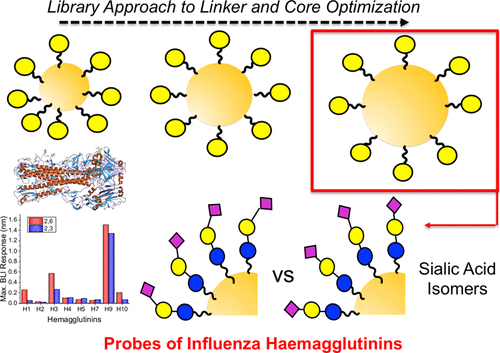当前位置:
X-MOL 学术
›
Biomacromolecules
›
论文详情
Our official English website, www.x-mol.net, welcomes your feedback! (Note: you will need to create a separate account there.)
Polymer-Stabilized Sialylated Nanoparticles: Synthesis, Optimization, and Differential Binding to Influenza Hemagglutinins.
Biomacromolecules ( IF 6.2 ) Pub Date : 2020-03-31 , DOI: 10.1021/acs.biomac.0c00179 Sarah-Jane Richards 1 , Alexander N Baker 1 , Marc Walker 2 , Matthew I Gibson 1, 3
Biomacromolecules ( IF 6.2 ) Pub Date : 2020-03-31 , DOI: 10.1021/acs.biomac.0c00179 Sarah-Jane Richards 1 , Alexander N Baker 1 , Marc Walker 2 , Matthew I Gibson 1, 3
Affiliation

|
During influenza infection, hemagglutinins (HAs) on the viral surface bind to sialic acids on the host cell's surface. While all HAs bind sialic acids, human influenza targets terminal α2,6 sialic acids and avian influenza targets α2,3 sialic acids. For interspecies transmission (zoonosis), HA must mutate to adapt to these differences. Here, multivalent gold nanoparticles bearing either α2,6- or α2,3-sialyllactosamine have been developed to interrogate a panel of HAs from pathogenic human, low pathogenic avian, and other species' influenza. This method exploits the benefits of multivalent glycan presentation compared to monovalent presentation to increase affinity and investigate how multivalency affects selectivity. Using a library-orientated approach, parameters including polymer coating and core diameter were optimized for maximal binding and specificity were probed using galactosylated particles and a panel of biophysical techniques [ultraviolet-visible spectroscopy, dynamic light scattering, and biolayer interferometry]. The optimized particles were then functionalized with sialyllactosamine and their binding analyzed against a panel of HAs derived from pathogenic influenza strains including low pathogenic avian strains. This showed significant specificity crossover, which is not observed in monovalent formats, with binding of avian HAs to human sialic acids and vice versa in agreement with alternate assay formats. These results demonstrate that precise multivalent presentation is essential to dissect the interactions of HAs and may aid the discovery of tools for disease and zoonosis transmission.
中文翻译:

聚合物稳定的唾液酸化纳米颗粒:合成,优化和差异绑定到流感血凝素。
在流行性感冒感染期间,病毒表面的血凝素(HAs)与宿主细胞表面的唾液酸结合。尽管所有HA均结合唾液酸,但人类流感的目标是末端α2,6唾液酸,禽流感的目标是α2,3唾液酸。对于种间传播(动物病),HA必须突变以适应这些差异。在这里,已开发出带有α2,6-或α2,3-唾液酸乳糖胺的多价金纳米颗粒,以询问一组来自病原性人类,低病原性禽流感和其他物种流感的HA。与单价呈递相比,该方法利用了多价聚糖呈递的好处来增加亲和力并研究多价如何影响选择性。使用面向库的方法,优化了包括聚合物涂层和芯径在内的参数,以实现最大结合,并使用半乳糖基化的颗粒和一系列生物物理技术[紫外可见光谱,动态光散射和生物层干涉法]探测了特异性。然后,将优化的颗粒用唾液酸乳糖胺官能化,并针对衍生自包括低病原性禽流感毒株在内的病原性流感毒株的一组HA进行结合分析。这显示出显着的特异性交叉,这在单价形式中未观察到,与备选测定形式一致,禽HA与人唾液酸结合,反之亦然。
更新日期:2020-04-23
中文翻译:

聚合物稳定的唾液酸化纳米颗粒:合成,优化和差异绑定到流感血凝素。
在流行性感冒感染期间,病毒表面的血凝素(HAs)与宿主细胞表面的唾液酸结合。尽管所有HA均结合唾液酸,但人类流感的目标是末端α2,6唾液酸,禽流感的目标是α2,3唾液酸。对于种间传播(动物病),HA必须突变以适应这些差异。在这里,已开发出带有α2,6-或α2,3-唾液酸乳糖胺的多价金纳米颗粒,以询问一组来自病原性人类,低病原性禽流感和其他物种流感的HA。与单价呈递相比,该方法利用了多价聚糖呈递的好处来增加亲和力并研究多价如何影响选择性。使用面向库的方法,优化了包括聚合物涂层和芯径在内的参数,以实现最大结合,并使用半乳糖基化的颗粒和一系列生物物理技术[紫外可见光谱,动态光散射和生物层干涉法]探测了特异性。然后,将优化的颗粒用唾液酸乳糖胺官能化,并针对衍生自包括低病原性禽流感毒株在内的病原性流感毒株的一组HA进行结合分析。这显示出显着的特异性交叉,这在单价形式中未观察到,与备选测定形式一致,禽HA与人唾液酸结合,反之亦然。



























 京公网安备 11010802027423号
京公网安备 11010802027423号